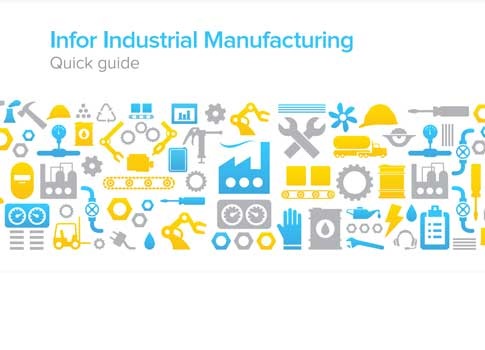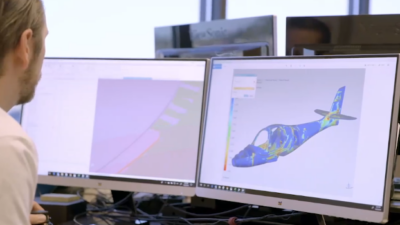Software enables predictive planning, performance monitoring, big data analytics, virtual modeling, and more informed-decision making.

In the manufacturing industry, necessity is driving a new wave of manufacturing software innovation and creative problem solving, building on the saying, "Necessity is the mother of invention." A need for product differentiation is compelling manufacturers to speed product introductions and design releases. This demand, plus current market pressures, requires looking more closely at the internal processes that are the backbone of modern manufacturing’s return to profitability. Here, ingenuity reigns.
Manufacturers face more economic, competitive, regulatory, and technological challenges than ever before. Only companies leveraging the technology tools available to them gain the intelligence quotient they need to survive. Software solutions provide the insight that fuels smarter decisions, smarter strategies, smarter processes, and smarter design of factory floors.
In the previous century, the quest to build "a better mousetrap" preoccupied the minds of the imaginative. Today, much of that creative energy is directed toward building a better mousetrap factory. Manufacturers have learned that the process is as important as the end product in this era when shaving cents or seconds off the cycle time means added revenue, happy customers, and increased market share. Optimizing performance is critical to profitability. This includes every step along the product design, development, production, and distribution supply chain. No department or function is exempt from scrutiny and refinement.
Lifecycle approach
Process design begins with a symbiotic balance of product lifecycle management (PLM) functionality to manage product releases and intelligent design of the shop floor to support the necessary work flows, quality control, and management of specific configurations-which may change for each customer. Modern end-to-end enterprise resource planning (ERP) solutions provide the real-time visibility required to monitor processes with analytical precision-down to the second, not just an hour or day. Data can be collected around all of the key functions, with added attention on the typical roadblocks or stumbling points, like inventory stock-outs or capacity constraints. Those basics can be addressed, of course, but today modern solutions and smart manufacturers go a step-or two or three-further.
Forward-thinking solution providers are now offering business intelligence tools that are more vertical-specific, are easier to use, and can be role-tailored. These applications provide highly consumable insights into decision-making. Contextual, relevant data is pushed to the user to facilitate decisions, rather than the user having to hunt for the information. This not only impacts behavior, it also guides the thought process. Users are led through their decision process, based on predefined best practices and parameters set by management.
Dashboards with KPIs
For the user, this means there are clearly defined procedures for nearly any incident that may occur. Role-based dashboards show key performance indicators (KPIs) that require continuous monitoring, Automatic alerts signal when an incident or level is outside of parameters. There is no more uncertainty or confusion on what is the prescribed action or what is expected. For managers, there is confidence that the workforce is alert and highly responsive, and that systems organization-wide are being monitored for any sign of noncompliance. Personnel-and the equipment they run-perform at their best ability, with automatic escalation alerts signaling when there is a potential obstacle to address. The goal is to identify issues early, when the outcome can still be influenced and proactive measures can be taken to avoid major delays or customer disappointment. Early warning is key.
For example, maintenance personnel may receive an alert on a tablet that one of the overhead cranes on the assembly line is "at risk for total failure." Several incidents can trigger the alert, such as a spike in temperature on the control panel, a fluctuation in speed that is outside of parameters, or a monitored decline in performance. In a smart manufacturing facility, this alert is just the beginning. In the model facility, also provided, automatically, are 3D images of the failing equipment with a schematic of the likely at-fault part.
History, insight, prediction
From there, the system can also provide inventory status of the replacement part, its replacement cost, history of purchase, preventive maintenance, other similar part failures, recommended lifespan of the part, warranties, and any supplier recommendations for upgrades or new model versions.
Now, also imagine this type of detailed operational insight, but applied in a predictive nature. Product intelligence, coupled with appropriate routing data, risk analysis, and quality control functionality, can predict possible outcomes of the options available to the maintenance foreman, such as replacing the suspect part with one in inventory, repairing the part, or letting the equipment continue running until the approaching failure actually happens. The system can also predict the cost of each option and the impact on current customer orders in the production queue.
This is what smart manufacturing is about-making well-informed decisions quickly, accurately, and within the predefined parameters of management’s guidelines. ERP solutions, machine to machine (M2M) connectivity, the Internet of things (IoT), smart sensors, and telemetry technology allow machines and people to communicate on complex variables affecting production. Personnel can monitor performance, anticipate incidents, and project possible outcomes with speed and accuracy.
Integrated input
Such integration of different technologies requires ERP software with highly flexible architectures. The most advanced, modern ERP solutions, purpose-built for manufacturing, can easily connect, consume, and store data from CAD (computer-aided design) drawings, 3D models, 3D-printing, bar codes, global positioning system (GPS) tracking, and radio frequency identification (RFID) time and temperature readings, as well as provide non-interrupted mobile connectivity.
The IoT, or industrial intranets, allow machines and people to connect with remarkable ease. Now, they speak the same language, the language of the Internet, and can harness that communication to be highly accurate, responsive, and imaginative. Machine readings of time, temperature, and weight can be measured in minute fractions of time and space difficult for mere humans to grasp. This extreme sensitivity and sensibility allow manufacturers to be acutely attuned to existing conditions and predict future incidents.
Smart manufacturing goes beyond monitoring individual pieces of equipment or a specific business unit process. Next-generation automation will make manufacturing smarter and more efficient with 3D simulation for installation engineering of automation lines, immersive virtual reality devices, and use of big data analytics for day-to-day decision support.
This entails 3D factory floor models and associated process modeling and simulation. While there have been packages to simulate factory floors for years, the newest technology makes it easier and faster to realistically plan entire manufacturing operations, from inventory to integration of production lines, use of robotics, material handling equipment, packaging, and order fulfillment and shipping systems. This modeling allows plant managers to work out details of throughput, dependencies, transportation between processes, and movement of raw materials from inventory to one workstation then the next, so that capacity is maximized.
Virtual modeling helps managers spot roadblocks in efficiencies, and helps operators predict capacity and make accurate projections to customers for as-promised delivery.
Smarter manufacturing
Software solutions make this level of predictive planning, monitoring of performance, big data analytics, virtual modeling, and informed decision-making possible. By taking advantage of these tools, manufacturers can be assured that processes run as efficiently as possible, and personnel are as productive as possible. Necessity is the mother of invention, indeed. In the case of smart manufacturing, necessity power-yielding, problem-solving innovation is available. The future of manufacturing is exciting, and it starts now.
– Mark Humphlett is industry and solution strategy director, Infor. Edited by Mark T. Hoske, content manager, CFE Media, Control Engineering, [email protected].
ONLINE
www.infor.com/industries/manufacturing/
See links at bottom for more information.
Key concepts
- Virtual modeling helps managers spot roadblocks in efficiencies, and helps operators predict capacity and make accurate projections to customers for as-promised delivery.
- Software improves predictive planning, monitoring of performance, big data analytics, and virtual modeling.
- Exciting future of manufacturing starts now.
Consider this
What software tools are helping to accelerate manufacturing efficiency?


